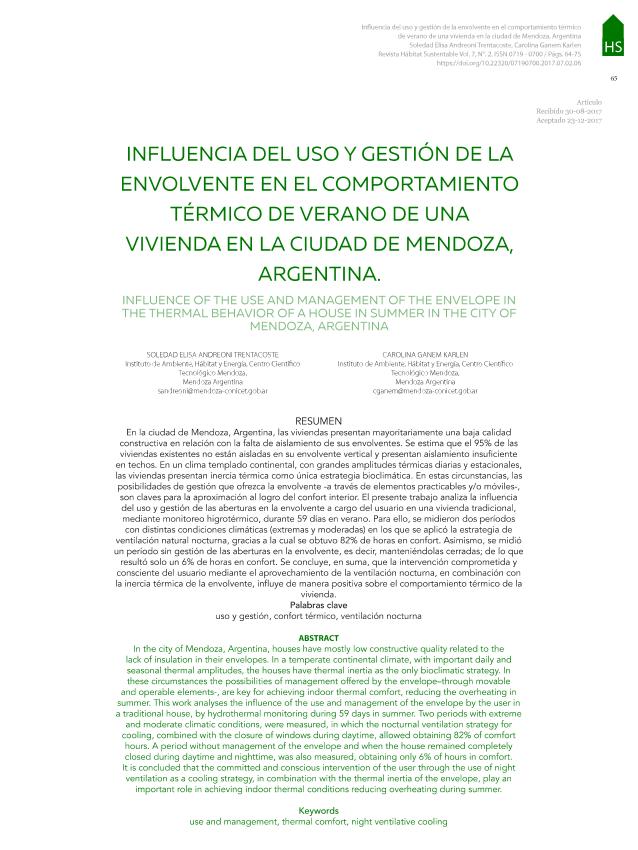Mostrar el registro sencillo del ítem
dc.contributor.author
Andreoni Trentacoste, Soledad Elisa

dc.contributor.author
Ganem, Carolina

dc.date.available
2018-08-31T00:05:53Z
dc.date.issued
2017-12
dc.identifier.citation
Andreoni Trentacoste, Soledad Elisa; Ganem, Carolina; Influencia del uso y gestión de la envolvente en el comportamiento térmico de verano de una vivienda en la ciudad de Mendoza, Argentina; Universidad del Bío-Bío; Hábitat Sustentable; 7; 2; 12-2017; 64-75
dc.identifier.issn
0719-0700
dc.identifier.uri
http://hdl.handle.net/11336/57848
dc.description.abstract
En la ciudad de Mendoza, Argentina, las viviendas presentan mayoritariamente una baja calidad constructiva en relación con la falta de aislamiento de sus envolventes. Se estima que el 95% de las viviendas existentes no están aisladas en su envolvente vertical y presentan aislamiento insuficiente en techos. En un clima templado continental, con grandes amplitudes térmicas diarias y estacionales, las viviendas presentan inercia térmica como única estrategia bioclimática. En estas circunstancias, las posibilidades de gestión que ofrezca la envolvente -a través de elementos practicables y/o móviles-, son claves para la aproximación al logro del confort interior. El presente trabajo analiza la influencia del uso y gestión de las aberturas en la envolvente a cargo del usuario en una vivienda tradicional, mediante monitoreo higrotérmico, durante 59 días en verano. Para ello, se midieron dos períodos con distintas condiciones climáticas (extremas y moderadas) en los que se aplicó la estrategia de ventilación natural nocturna, gracias a la cual se obtuvo 82% de horas en confort. Asimismo, se midió un período sin gestión de las aberturas en la envolvente, es decir, manteniéndolas cerradas; de lo que resultó solo un 6% de horas en confort. Se concluye, en suma, que la intervención comprometida y consciente del usuario mediante el aprovechamiento de la ventilación nocturna, en combinación con la inercia térmica de la envolvente, influye de manera positiva sobre el comportamiento térmico de la vivienda.
dc.description.abstract
In the city of Mendoza, Argentina, houses have mostly low constructive quality related to the lack of insulation in their envelopes. In a temperate continental climate, with important daily and seasonal thermal amplitudes, the houses have thermal inertia as the only bioclimatic strategy. In these circumstances the possibilities of management offered by the envelope–through movable and operable elements-, are key for achieving indoor thermal comfort, reducing the overheating in summer. This work analyses the influence of the use and management of the envelope by the user in a traditional house, by hydrothermal monitoring during 59 days in summer. Two periods with extreme and moderate climatic conditions, were measured, in which the nocturnal ventilation strategy for cooling, combined with the closure of windows during daytime, allowed obtaining 82% of comfort hours. A period without management of the envelope and when the house remained completely closed during daytime and nighttime, was also measured, obtaining only 6% of hours in comfort. It is concluded that the committed and conscious intervention of the user through the use of night ventilation as a cooling strategy, in combination with the thermal inertia of the envelope, play an important role in achieving indoor thermal conditions reducing overheating during summer.
dc.format
application/pdf
dc.language.iso
spa
dc.publisher
Universidad del Bío-Bío
dc.rights
info:eu-repo/semantics/openAccess
dc.rights.uri
https://creativecommons.org/licenses/by/2.5/ar/
dc.subject
Uso y Gestión
dc.subject
Confort Térmico
dc.subject
Ventilación Nocturna
dc.subject.classification
Otras Artes

dc.subject.classification
Arte

dc.subject.classification
HUMANIDADES

dc.title
Influencia del uso y gestión de la envolvente en el comportamiento térmico de verano de una vivienda en la ciudad de Mendoza, Argentina
dc.title
Influence of the use and management of the envelope in the thermal behavior of a house in summer in the city of Mendoza, Argentina
dc.type
info:eu-repo/semantics/article
dc.type
info:ar-repo/semantics/artículo
dc.type
info:eu-repo/semantics/publishedVersion
dc.date.updated
2018-08-28T19:00:47Z
dc.journal.volume
7
dc.journal.number
2
dc.journal.pagination
64-75
dc.journal.pais
Chile

dc.journal.ciudad
Concepción
dc.description.fil
Fil: Andreoni Trentacoste, Soledad Elisa. Consejo Nacional de Investigaciones Científicas y Técnicas. Centro Científico Tecnológico Conicet - Mendoza. Instituto de Ambiente, Hábitat y Energía; Argentina
dc.description.fil
Fil: Ganem, Carolina. Consejo Nacional de Investigaciones Científicas y Técnicas. Centro Científico Tecnológico Conicet - Mendoza. Instituto de Ambiente, Hábitat y Energía; Argentina
dc.journal.title
Hábitat Sustentable
dc.relation.alternativeid
info:eu-repo/semantics/altIdentifier/url/http://revistas.ubiobio.cl/index.php/RHS/article/view/2931
dc.relation.alternativeid
info:eu-repo/semantics/altIdentifier/doi/http://dx.doi.org/10.22320/07190700.2017.07.02.06
Archivos asociados
